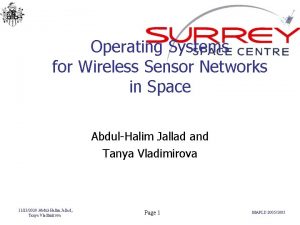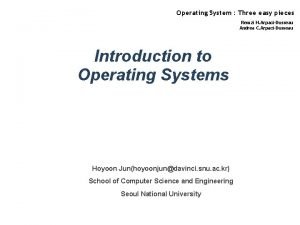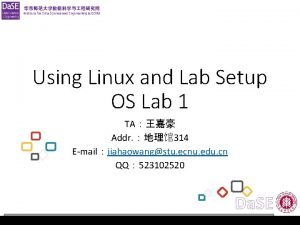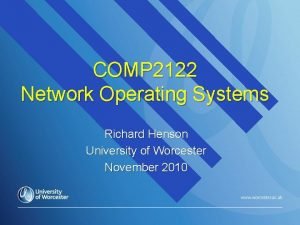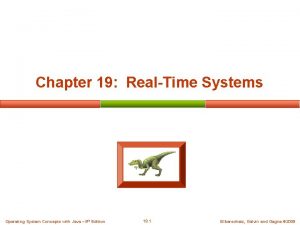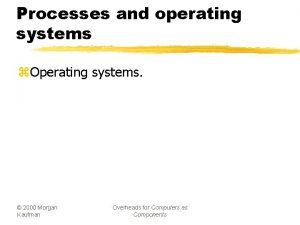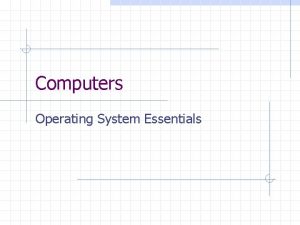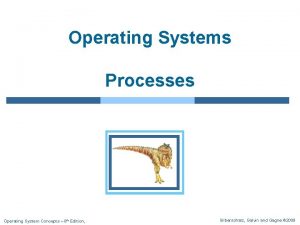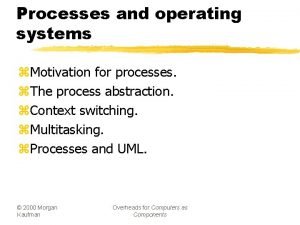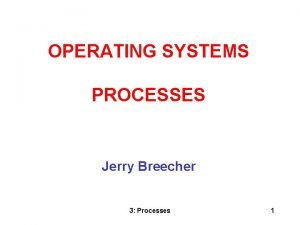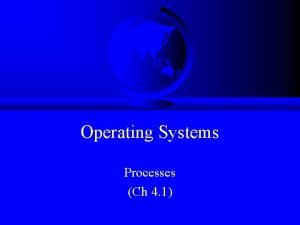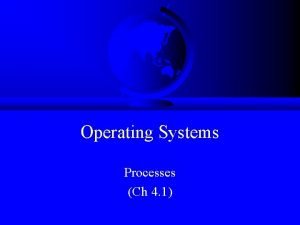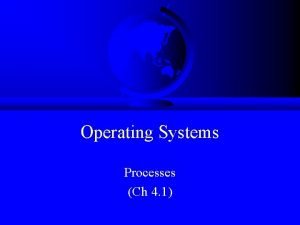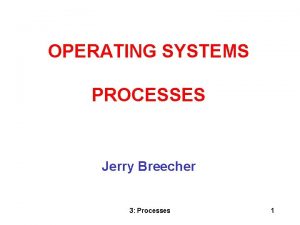Operating Systems Processes Ch 3 1 Processes A













- Slides: 13

Operating Systems Processes (Ch 3. 1)

Processes • “A program in execution” • Modern computers allow several at once – “pseudoparallelism” A Program Counter B C A B C Conceptual View A B C Time

Processes • “A program in execution” main() {. . . } A() { … } Heap A Stack main • “more” than a program: ls, tcsh • “less” than a program: gcc blah. c (cpp, cc 1, cc 2, ln …) • “A sequential stream of execution in it’s own address space”

Process States • Consider: cat /etc/passwd | grep claypool Exit New Running Dispatch I/O Wait Interrupt Ready I/O Complete Waiting (Hey, you, show states in top!)

Design Technique: State Machines • Process states • Move from state to state based on events – Reactive system • Can be mechanically converted into a • program Other example: – string parsing, pre-processor

Unix Process Creation • System call: fork() – creates (nearly) identical copy of process – return value different for child/parent • System call: exec() – over-write with new process address space • Shell – uses fork() and exec() – simple! • (Hey, you, show demos!)

Process Scheduler cat ls . . . disk vid Scheduler • All services are processes • Small scheduler handles interrupts, stopping and starting processes

Process Control Block • Each process has a PCB – – – state program counter registers memory management … • OS keeps a table of PCB’s, one per process • (Hey! Simple Operating System, “system. h”)

Interrupt Handling • Stores program counter (hardware) • Loads new program counter (hardware) – jump to interrupt service procedure • Save PCB information (assembly) • Set up new stack (assembly) • Set “waiting” process to “ready” (C) • Service interrupt (C and assembly) • Scheduler (C) – Newly awakened process + Often called a context-switch – Previously running process

Context Switch • Pure overhead • So … fast, fast – typically 1 to 1000 microseconds • Sometimes special hardware to speed up • Real-Time wants worse case • – RT Linux worse case sub 20 microseconds How to decide when to switch contexts to another process is process scheduling

Linux Context Switch Times (http: //math. nmu. edu/~benchmark/) Measured with LMBench

Processes in Linux • PCB is in struct task_struct – states: RUNNING, INTERRUPTIBLE, UNINTERRUPTIBLE – priority: when it runs – counter: how long it runs • Environment inherited from parent • NR_TASKS max, 2048 – 1/2 is max per user

Processes in Windows • States: ready, standby (first in line), running, • • waiting, transition, terminated priority - when it runs Processes are composed of threads – (revisit threads after synchronization)
 Concurrent processes are processes that
Concurrent processes are processes that Example of an operating system
Example of an operating system Evolution of operating systems
Evolution of operating systems Components of an operating system
Components of an operating system Operating system components
Operating system components Wsn operating systems
Wsn operating systems Three easy pieces
Three easy pieces Operating system lab
Operating system lab What is dual mode in os
What is dual mode in os Operating systems structure
Operating systems structure File management in operating system
File management in operating system Design issues of distributed file system
Design issues of distributed file system Early operating systems
Early operating systems Real-time operating systems
Real-time operating systems





